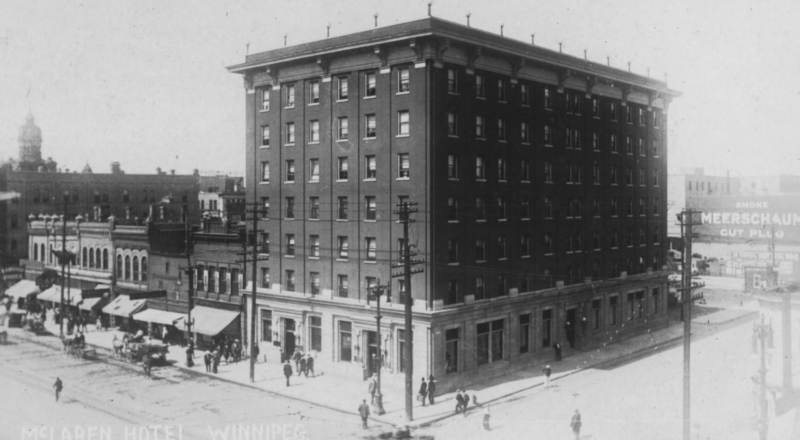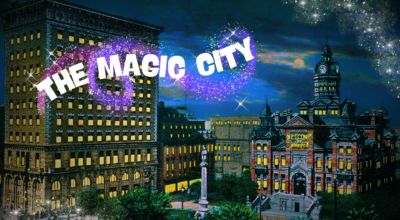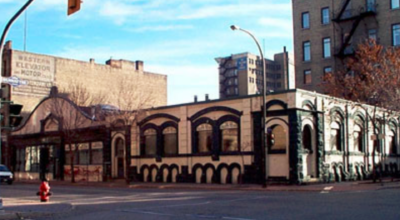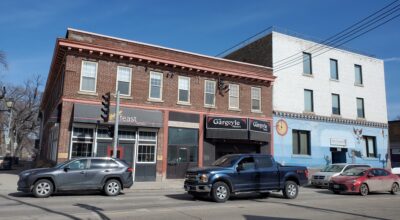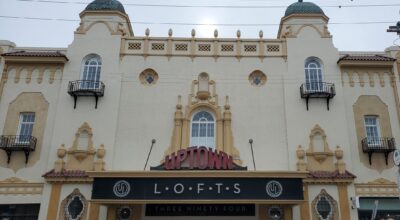
/ Blog
August 28, 2019
Majesty on Main Street – The McLaren Hotel
The McLaren Hotel opened to great acclaim in 1911, said to be one of the finest hotels in Canada. An unmistakable red brick building in the downtown, the hotel has long outlived many of its contemporaries, still standing over 100 years later at the intersection of Main Street and Rupert Street. It was the final and greatest achievement of the three McLaren brothers, pioneers in Winnipeg’s hospitality industry, and all that remains of their empire. Although much has changed inside the hotel over the century, from ornate accomidations to low income housing, the exterior is still a direct connection to early 20th century Winnipeg. Now nominated for a municipal heritage designation, the importance of the building is being recognized and will hopefully allow it to shelter those in need for many years to come.
When the Canadian Pacific Railway reached Winnipeg in 1883, it ushered in an era of prosperity and growth that saw the city flourish until the start of the First World War. Wholesale products from the east were stored in Winnipeg’s warehouse district (now the Exchange District National Historic Site) before being shipped westward, while grain from the west passed through Winnipeg on its way to eastern customers. Immigrants from all over the world set out to make their fortune in Winnipeg or stayed in the city before traveling further west to settle on homesteads. The financial district with banks from across Canada quickly established “Bankers’ Row” on Main Street between Portage Avenue and City Hall, cutting through the middle of the warehouse district. What had started out as wooden shacks on dirt roads when Winnipeg was incorporated in 1873 had become the fastest growing city in North America in just over 30 years – a place where everyone wanted to be.
With people pouring into the city, places to stay were in high demand. The three McLaren brothers, Archibald, John Angus and Alexander Stewart, built their businesses around meeting this demand. The sons of hotel keepers from Ontario, Alexander arrived in Winnipeg in 1878 and quickly opened a boarding house. Archibald, who had been homesteading in the Pilot Mound district of Manitoba, moved to the city in 1880 to partner with his brother Alexander in the hotel business. They built their first hotel, the Brunswick Hotel, at 571 Main Street, in 1881. Well located just north of City Hall, Bankers’ Row and the warehouse district, it was a successful business that allowed the brother to retire by 1904. Their retirement was short lived, as that same year an opportunity arose that they could not resist- the Cauchon Block.
John, who had been operating hotels in Selkirk and Brandon, arrived in Winnipeg to help with the new project. Together, the three McLaren brothers purchased the Cauchon Block at 171 Main Street and converted it from an apartment block to luxurious hotel, opening it as the Empire Hotel in 1905. Two years later the three brothers purchased a third hotel, the Strathcona Hotel, which at 567 Main Street was just across Rupert Street from their first hotel. Another two years after that, in 1909, the brothers sold the Empire Hotel, refocusing their efforts on the intersection of Main Street and Rupert Street. In 1910 they purchased the property at 554 Main Street, located at the southwest corner of the intersection. A two storey brick building stood on the property, built by the Manitoba Electric and Gas Light Company. Shabby in comparison to its newer neighbours, the building was demolished to make way for the McLearn’s new hotel.

The Empire Hotel stood at 171 Main Street until it was demolished in 1982.
Source: Martin Berman Postcard Collection (public domain via Winnipeg Public Library)
Architect John Cooke Caldwell was hired to design the hotel, taking advantage of new steel frame technology to create a seven storey building in the Chicago School style. Construction of the 20.1 meter by 40 meter building started in the summer of 1910, only running into difficulties in September that year. On September 16, 1910, the neighbouring building on Main Street, the Manitoba Clothing Company, suffered a partial collapse due to the construction of the new hotel’s foundation. Fortunately, the owner of the Manitoba Clothing Company had noticed plaster falling from the ceiling of his office and acted quickly, evacuating the building in time to see the back of it collapse less than two minutes later. The contractors for the hotel, Charles W. Sharp and Son, worked through the night stabilizing and rebuilding the collapsed building so that it could open later the next day.
On September 15, 1911, the new hotel, christened the McLaren Hotel, opened to the public. Costing about $165,000 to build, it was the second most costly hotel built in Winnipeg from 1910 to 1915, only trumped by the Canadian Pacific Railway’s grand Fort Garry Hotel. Designed to complete with the Royal Alexandra Hotel, it featured fine finishes and modern amenities. The facades on Main Street and Rupert Street where clad in stone on the first floor with large windows, red Menomonie brick on the upper floors with a regular grid pattern of windows, and crowned with a large metal cornice supported by ornate corbels. The south and west facades were finished in plain clay brick, with the south wall featuring two large light wells and advertising. A flagpole on the northeast corner of the roof potentially functioned as a lightening rod. This would have ensured that if the building was struck the lightening would be safely diverted into the ground as opposed to striking the metal fire escape on the west side of the building and causing a fire, much like what happened to the Scott Block.
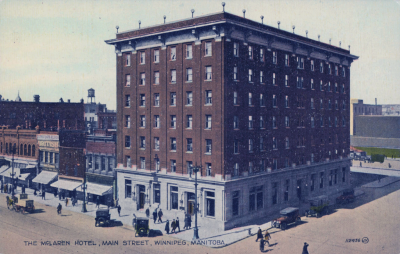
The McLaren Hotel at 554 Main Street some time after 1910.
Source: Rob McInnes Postcard Collection (public domain via Winnipeg Public Library)
The first floor of the McLaren Hotel featured a lobby, rotunda, writing room, bar and dining room. The lobby was “quite pretentious”, decorated with ornate columns and cornice work. The large rotunda also had many fine finishes including mosaic tile floors, Spanish burlap walls, pillars, white oak and brass fittings. Just off the rotunda was the writing room, with 12 desks for guests to use, a spacious dining room and a bar with a large counter of mahogany and marble. Beneath the lobby was a full basement where the building’s mechanical systems were situated along with a pool and billiards room and a barber shop, ensuring all the guests’ needs were met. Rising above the lobby, the upper six floors were finished in plaster and fir trim, each floor with about 25 guest rooms and four shared washrooms. When the hotel opened in 1911, rooms were being advertised starting at $2.50 per day.
The rotunda will be finished with marble and tile work, and the interior fittings will be of the finest possible quality, and of the most modern character. There will be approximately 161 rooms in the hotel, the construction being fireproof throughout.
Only ten years after opening, all three of the McLaren brothers had passed away. The hotel was sold and would change hands many times through the decades. Over time all the McLaren brothers’ other hotels would all be demolished in the name of progress. The Brunswick Hotel became a parking lot, the Empire Hotel also became a parking lot, although part of the facade is now in the Franco-Manitoban Cultural Centre, and the Strathcona Hotel was replaced with the Manitoba Museum. But the McLaren Hotel had soldiered on, long outliving its main competition, the Royal Alexandra Hotel, which was demolished in 1971. The interior of the hotel has been significantly altered over time, with the grandeur of the first floor long since gone. The exterior though has been retained much in its original condition, just as the McLaren’s built it.
The McLaren Hotel was a respectable establishment that many people stayed at, dined at or even worked at throughout the years. The Watchmen, a rock and roll band from Winnipeg, named their first album the “McLaren Furnace Room” after the actual furnace room in the hotel which the band used as a practice space. Over time the hotel’s clientele changed, from businessmen and travelers to low income individuals in need of affordable housing. As of 2019, the hotel functions much as a single room occupancy (SRO), returning to the McLaren’s boarding house roots.

Looking north down Main Street, circa 1912. The McLaren Hotel is visible mid way down Main Street on the left hand side.
Source: Martin Berman Postcard Collection (public domain via Winnipeg Public Library)
In July of 2019, the McLaren Hotel was nominated for the City of Winnipeg’s List of Historical Resources. This proposed heritage designation would prevent the demolition of the building and protect the building’s character defining elements, which are various components of the exterior of the building. If this nomination is successful, the hotel could continue to provide much needed affordable housing with no limitations on what alterations could be done to the interior, while the the historic exterior of the building would be conserved. This would also allow the owner to apply for grants to help conserve the building, which would seem to be much needed as records show the last time a permit was pulled to do work on the building was 2007, when $5000 was spent to make alterations for the new sushi restaurant that was moving in. Further, comments from current residents and permits for only $12,000 of work in the last 25 years suggest that the building is in need of both maintenance and conservation work.The McLaren Hotel is an important connection to Winnipeg’s past, providing shelter for countless individuals as it served as a hotel for over 100 years. A structurally sound building, it has many good years of use left in it, and with a heritage designation it could still being adaptively reused in a variety of ways. Heritage Winnipeg supports the proposed designation of the hotel that will be discussed at City Hall in September and feels that well managed SROs play an important role in providing affordable housing. With proper maintenance and conservation, the McLaren Hotel will continue to welcome visitors and Winnipeggers alike as they enter the downtown, a tangible connection to the trailblazers who made the city into a cosmopolitan metropolis admired throughout the world in the early 20th century.
Featured image: The McLaren Hotel at 554 Main Street, some time after 1910.
Source: Rob McInnes Postcard Collection (public domain via Winnipeg Public Library)
THANK YOU TO THE SPONSOR OF THIS BLOG POST:

Written by Heritage Winnipeg.
SOURCES:
554 Main Street | Canadian Inventory of Historic Buildings
1910 - McLaren Hotel, Winnipeg, Manitoba | archiseek
Employees escape falling building | Page 6 - September 17, 1910 - Winnipeg Free Press
Exchange District National Historic Site | City of Winnipeg
Hotel contract let | Page 7 - July 30, 1910 - Winnipeg Free Press
How Lightning Works | John Zavisa & Jesslyn Shields - May 5, 2022 - HowStuffWorks
Occupy Main Street | Manitoba Museum
The Cauchon Block / Empire Hotel | Christian Cassidy - This Was Manitoba





